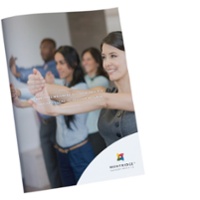
Melissa Montoril
Melissa is an employee benefits specialist with over ten years of experience in group insurance.
If you are reading this article, you most likely want to create a safer and healthier environment for your team. As promised, we will provide you with tips, but first, we’d like you to pause for a moment and reflect on what office safety really means. Are you thinking about ergonomic desks, good lighting, fire safety, and first aid kits? Great! These are the must-haves, which we will take a closer look at later in the article.
But first, let’s talk about psychological safety.
Promote psychological safety
The term and concept of psychological safety in the workplace are relatively new. It has been discussed by Google, academics, and long-form journalists since 2010. Psychological safety aims to reduce emotional harm, which is unfortunately not uncommon in many workplaces. Even in process-driven environments, emotions can still run high, and you may not be protected from emotional harm at the highest level by default. Unfortunately, many people still cry at or because of work.
Psychological safety is the belief that employees can express their thoughts without worrying about being humiliated or punished.
According to a Google study called "Project Aristotle," psychological safety is the most important factor for the success of a high-performing team.
Psychological safety tips
- Create rituals that help develop a routine around measures promoting a healthy work culture and a supportive, caring environment. Start by fostering open, constructive feedback, avoiding punishment for failure, and welcoming it instead. Support transparency in communication and information flow.
- Establish a DEI policy and ensure its practical implementation.
- Train team managers to be more supportive and create anonymous feedback channels for honest feedback about senior leadership. They have a significant impact on shaping the company culture, so help them do things right.
- Care for employees' mental health.
- If you take psychological safety seriously and want to start implementing small activities today, this collection of community ideas on how to approach psychological safety might be helpful.
As workplaces have evolved, so also has the focus on safety. While physical safety was vital in industrial workplaces of the past, post-industrial settings now emphasize employees' emotional and psychological well-being. This means protecting them from fears such as job loss or damage to their reputation, especially in corporate environments.
With the new reality of remote and hybrid work arrangements, we need to refresh our approaches to work safety once again.
Do your processes and policies still work for the hybrid work mode?
As companies shift towards a hybrid work model, it is crucial to evaluate whether your current processes and policies are still effective. One key area to consider is your physical workspace. Is it equipped to accommodate both remote and in-person workers? Are there enough resources available to support everyone's needs?
It is also essential to review your data protection measures and ensure that all portable devices are secure and up-to-date.
Another critical aspect of a successful hybrid work model is communication. With some team members working remotely and others in the office, it's crucial to establish clear communication channels to ensure everyone stays on the same page. This could involve regular team meetings, using collaboration tools, or providing training on effective remote communication.
By carefully reviewing and adjusting your procedures and policies, you can confidently adopt a hybrid work model that will improve your organization and empower your employees.
Now, let's shift our focus back to physical safety in the office.
Don't wait until an accident, injury, or illness happens. Take the initiative to enhance workplace safety. Here are seven office health and safety tips to help your employees (and your company) thrive!
Physical safety in the office
Develop and communicate the workplace safety plan
A key part of employee wellness is addressing workplace hazards. Your employees are firsthand experts on real-life dangers they encounter every day. Schedule a staff meeting to get their input and discuss these risks. They might include insecure filing cabinets, tripping hazards, dangerous moving objects, or electrical hazards.
Don't only record their answers, but brainstorm together about possible solutions. Test the solutions before officially including them in your office safety guidelines. Then pick someone to follow through and perform regular safety checks to ensure conditions indeed improve.
Prevent costly injuries by promoting a healthy sitting posture
Office settings typically mean prolonged sitting for employees. Advise them on sitting basics: The pelvis should slightly tilt forward, with the buttocks should press against the back of the chair. The feet lie flat on the floor, with the knees at hip height.
Be sure to rest the elbows or forearms on the chair or desk. Eye level should aim for the center of the computer display.
Chair preferences can vary widely. While most people need lumbar support, some benefit from standing desks or alternative chairs, such as active chairs or the Norwegian kneeling chair. Provide the best chairs that you can afford—and let employees pay the difference if they want specific pricier items.
(Related post: How to Exercise at Work)
Prepare your team for the unexpected: Educate them on first aid and CPR
Rapid response can make a big difference in injuries and medical emergencies. Offer first aid and CPR training and certification courses for employees.
Purchase a complete first aid kit for each floor that your company occupies—and tell employees where to find them. Make sure that items are clearly labelled. Do regular inventory counts and restock supplies running low or past expiry dates.
Keep your team productive by encouraging proper eye care
Nowadays, office work means staring at a computer for hours on end. Some people have eye fatigue and strain, making it hard to focus on work. But simple breaks and equipment can lessen potential issues.
Tell employees to remember the three 20s: After 20 minutes, for 20 seconds, look 20 feet away. (Set a desktop or cell phone reminder to make it a habit.) In addition, occasionally take a longer break and do eye relaxation exercises.
To reduce eye strain, install an anti-blue light screen filter, such as f.lux or Apple Night Shift, on office digital devices. For workplace lighting, use both overhead and desktop task lighting, a combination proven to be visually optimal.
Address poor environmental factors to avoid "Sick Building Syndrome"
Be aware of "sick building syndrome" (SBS), a condition typically marked by headache, fatigue, and respiratory distress, affecting office workers. The causes include harmful or stressful environmental factors such as poor heating, ventilation, and air conditioning (HVAC) systems, chemicals in building materials, and moulds.
In addition to selecting a high-quality worksite and checking on building maintenance, regularly assess the office air temperature and adjust for comfort. Provide flu vaccinations and other health screenings for employees. Encourage people to take sick days off if they feel unwell to prevent them from spreading cold and flu viruses.
Create a pleasant environment by maintaining a clean office space
Establish firm policies for cleanliness in the workplace. Emphasize that it's everyone's responsibility to keep the office clean and tidy. Pay special attention to the kitchen: Wash dirty dishes daily. Ensure that the fridge and cupboards are regularly cleared out.
Also, discreetly promote personal hygiene among employees. No one should arrive at work with contagious illnesses or unwashed clothing. Provide hand sanitizers and disinfecting wipes—and recommend cleaning shared items, such as meeting tables, desks, and keyboards, between uses.
Keep employees focused and comfortable with a fragrance-free policy
Many people are sensitive to fragrances, whether in perfumes, personal care products, or office cleaning supplies. Fragrances can trigger headaches, dizziness, or allergic reactions.
Banning fragrances can be a touchy matter. Address all employees’ concerns about this topic openly and honestly. If you point out the debilitating effects that fragrances can cause, people will understand why such a policy is needed.
Wait, there is more …
People are the main driver of your success and are your company's main asset, so you’d better take care of their wellbeing. Once you have taken care of the basics, you can zoom out for a more holistic view of workforce wellbeing. Consider A New Work Wellness Model for inspiration.
Conclusion
Although not always top of mind for office workers, it’s critical to emphasize the importance of health and safety in the workplace. Doing so will help you prevent costly and disruptive injuries, accidents, and illnesses. Getting everyone on the same page about potential hazards and educating employees on how to avoid them is key to maintaining a healthy, productive workforce. By focusing on workplace wellness, your team and your company will thrive!
Have another great workplace health and safety tip? Let us know in the comments what’s worked well for you or if you have a great idea you want to share.







